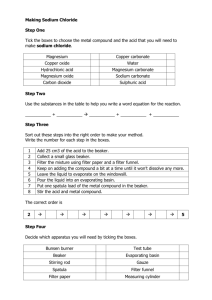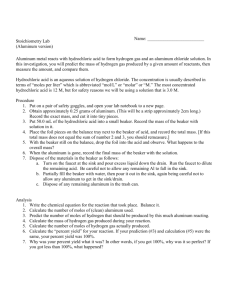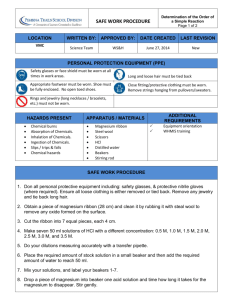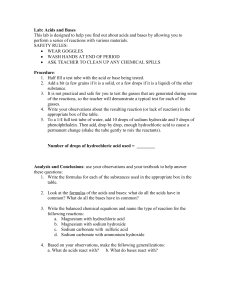Lab 1
advertisement
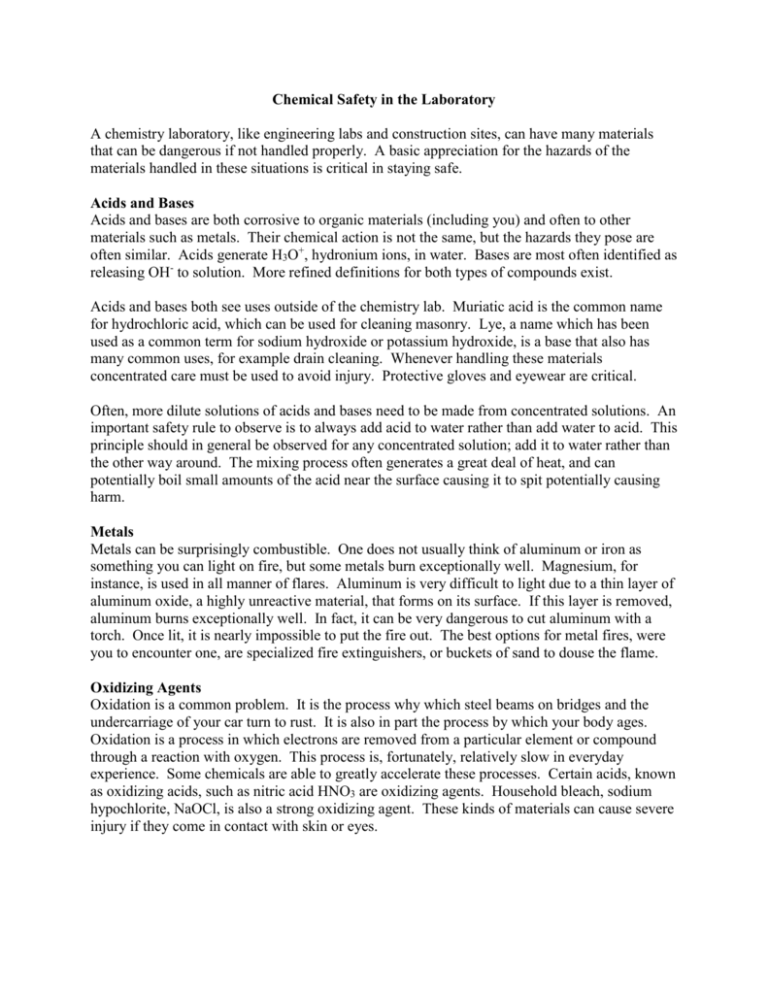
Chemical Safety in the Laboratory A chemistry laboratory, like engineering labs and construction sites, can have many materials that can be dangerous if not handled properly. A basic appreciation for the hazards of the materials handled in these situations is critical in staying safe. Acids and Bases Acids and bases are both corrosive to organic materials (including you) and often to other materials such as metals. Their chemical action is not the same, but the hazards they pose are often similar. Acids generate H3O+, hydronium ions, in water. Bases are most often identified as releasing OH- to solution. More refined definitions for both types of compounds exist. Acids and bases both see uses outside of the chemistry lab. Muriatic acid is the common name for hydrochloric acid, which can be used for cleaning masonry. Lye, a name which has been used as a common term for sodium hydroxide or potassium hydroxide, is a base that also has many common uses, for example drain cleaning. Whenever handling these materials concentrated care must be used to avoid injury. Protective gloves and eyewear are critical. Often, more dilute solutions of acids and bases need to be made from concentrated solutions. An important safety rule to observe is to always add acid to water rather than add water to acid. This principle should in general be observed for any concentrated solution; add it to water rather than the other way around. The mixing process often generates a great deal of heat, and can potentially boil small amounts of the acid near the surface causing it to spit potentially causing harm. Metals Metals can be surprisingly combustible. One does not usually think of aluminum or iron as something you can light on fire, but some metals burn exceptionally well. Magnesium, for instance, is used in all manner of flares. Aluminum is very difficult to light due to a thin layer of aluminum oxide, a highly unreactive material, that forms on its surface. If this layer is removed, aluminum burns exceptionally well. In fact, it can be very dangerous to cut aluminum with a torch. Once lit, it is nearly impossible to put the fire out. The best options for metal fires, were you to encounter one, are specialized fire extinguishers, or buckets of sand to douse the flame. Oxidizing Agents Oxidation is a common problem. It is the process why which steel beams on bridges and the undercarriage of your car turn to rust. It is also in part the process by which your body ages. Oxidation is a process in which electrons are removed from a particular element or compound through a reaction with oxygen. This process is, fortunately, relatively slow in everyday experience. Some chemicals are able to greatly accelerate these processes. Certain acids, known as oxidizing acids, such as nitric acid HNO3 are oxidizing agents. Household bleach, sodium hypochlorite, NaOCl, is also a strong oxidizing agent. These kinds of materials can cause severe injury if they come in contact with skin or eyes. Procedure Chemicals and Organic Matter Eggs are made mostly of protein. This is the same material that your skin, flesh, and eyes are made of. Observe the reaction of eggs and several different chemicals to get a feel for the effects of caustic materials on biological materials (like you). Sugar is also an organic material. It is a chemical cousin of cellulose, which most plant material contains in great amount. It is also not too dissimilar from many molecules that people are made of. Materials: Egg white Small beakers or watch glasses 16 M nitric acid (HNO3) bleach 6M sodium hydroxide (NaOH) 50 ml beaker 18 M sulfuric acid (H2SO4) sugar (sucrose, C12H22O11) glass stirring rod Put a sample of egg whites in three separate containers. Add a few drops of nitric acid to one, bleach to another, and sodium hydroxide to the third. Observe what happens to the egg over time. Do the following in a hood! Place 10g of sugar in a 50 ml beaker. Add 10 ml of sulfuric acid, and stir thoroughly. Observe the color changing as you stir. Once thoroughly mixed, close the hood sash and wait until something dramatic happens. Chemical Spills Chemical spills need to be cleaned up quickly and correctly to prevent potential exposure. A few drops of acid on a table can easily later get on your hands and burn you. One inattentive scratch, and your chemical contaminated hand could even get chemicals in your eyes. Often neutralizing a spill before cleaning it up is an important step, especially for acid spills. Materials: 6M hydrochloric acid large beaker sodium bicarbonate (NaHCO3) In a hood, pour ~5 ml of hydrochloric acid in the bottom of your large beaker. This simulates a spill. Add sodium bicarbonate and carefully mix. Note the vehement reaction. You must add sodium bicarbonate until all of the acid has reacted. You may need to use a scoopula to mix the contents to get the acid all to react. Once there is no more foaming, scrape al of the contents out and into the proper waste container. If you were cleaning up a benchtop, you would have to wipe up any residue left over with a wet towel and also put that in chemical waste. Metals and Corrosion As previously mentioned metals can be quite reactive. Observe the following reactions of aluminum and magnesium. Materials: 6M NaOH beaker aluminum foil magnesium Fold a piece of aluminum foil one or two inches on a side into a small bowl shape. Place it at the bottom of a beaker. Pour 1-2 ml of NaOH into the middle. Observe the beaker until a reaction occurs. It may take a little while to get going. Do the following in a hood. Get a strip of magnesium a few inches long. Light a Bunsen burner. Light the magnesium with the burner. Do not look directly at the flame. Analysis Describe the effects of various chemicals on eggs. Describe the effects of sulfuric acid on sugar. What is likely to happen if you expose yourself to the same chemicals? Describe your clean up procedure for the chemical spill. Why might it be important to neutralize the acid before cleaning it up? Describe the reaction of aluminum. What purpose might having aluminum in Drano serve? Describe the reaction of magnesium.


